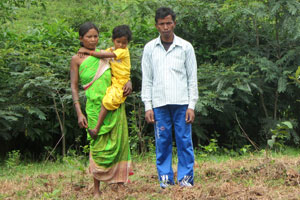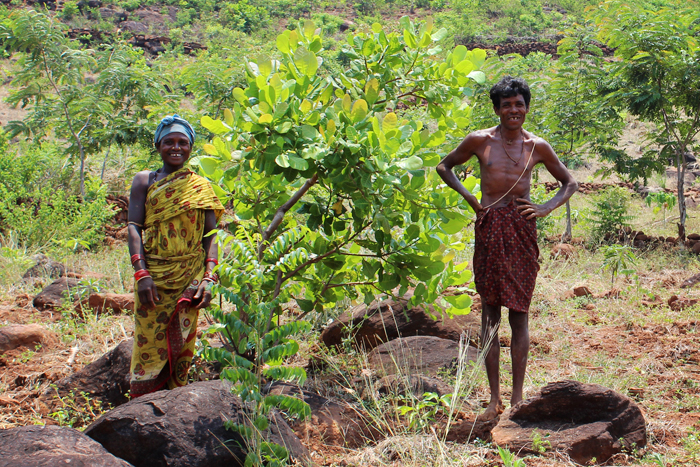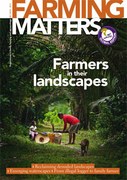In southern Odisha state, India, the landscape and livelihoods of family farmers are threatened by large dams, changing rainfall patterns and government indifference. But tribal communities have decided how they want to conserve their land for their own benefit. And they are doing it.
Podu chaso, as shifting cultivation is called in the tribal regions of Odisha, India, is important for the diversity of crops it has helped to sustain, and the diversity of cultivation practices it has generated. Crop rotations, intercropping, and other sustainable agricultural practices are a part of the inherited knowledge system of podu farmers, and have helped to create the landscape in which they live.
However, all of this is becoming increasingly threatened. Commercial logging has devastated huge tracts forests used by the tribal communities, and the food and fuel that used to be gathered there by tribal women has almost completely disappeared. The area also continues to suffer from lopsided development, with roads, railways and dams being built to attract corporate investment at the cost of tribal land and livelihoods. In Koraput region alone, more than half a million people have been displaced due to the construction of new reservoirs, and more than ten thousand hectares of forest land destroyed.
Alternatives
Consecutive governments in India have adopted the TINA (‘there is no alternative’) philosophy for addressing poverty, based on claims that despite various policies and programmes aimed at promoting rural development, poverty persists in the tribal regions. The only solution, they say, requires the input of corporate capital. However, multimillion dollar investment projects lead to displacement and have only further impoverished tribal communities rather than helping them.
On top of this, climate change has also affected the region’s rainfall, cultivation practices and fragile environment. The combined result is an almost total end of the podu system of cultivation, threatening the livelihoods of the tribal communities. Hunger is now commonplace, and some live on the brink of starvation. Their rich forests have disappeared. Their luxurious hill slopes where they used to grow up to ten different crops together in a single season have turned to barren soil and rock. But on which they keep trying their podu in desperation, trying to relive the memories of those bountiful days from not so long ago…
Addressing the situation with a holistic, people-centred approach was seen by some as the only alternative to ‘there is no alternative’. Agragamee, a group of activists committed to working with marginalised and underprivileged communities in the tribal districts of Odisha, began talking with family farmers in the affected areas. Based on their experience, a series of consultations with 25 tribal villages began. Together, they looked for sustainable, agroecological alternatives that would help the tribal communities preserve their cropping patterns and produce enough food.
Farmers decide
In Chandragiri Panchayat in Rayagada District, farmers pointed out the need to address their problems in an organised and multipronged approach to counter the many threats they saw to their landscape. This included controlled use of communal land, improved soil and water management, moving towards settled cultivation, and rejuvenating uplands with plantations and permanent tree crops that would provide livelihood support as well as cash incomes.
This looked like a huge task, and a real challenge for tribal farmers who have few resources other than a little land and their own labour. But even the longest journey begins with a single step. Their chosen first step was to establish a framework for improving governance of their resources, and rules emerged from a process of dialogue and discussion. These were: controlling the open grazing of cattle, protection of all forests, having every child in school, ensuring collective labour for village development, everybody to have compost pits, and no use of alcohol or tobacco.
This was followed by further discussions on land use, and the first agreement was to improve agricultural practices and soil fertility, and other plans began to emerge. The community felt that they had been very short sighted in the past by neglecting plantations and orchards and allowed them to die. Less than 5% of tribal farmers had taken the trouble to maintain their cashew and mango plantations, but they were getting significant cash returns while others were in penury. The village decided they would take action at three levels. The first, governance, was to be based on the rules above. The second would be collective efforts to rejuvenate the commons – a prime need emphasised by women. The third would be to move away from shifting cultivation to settled plots, intensifying energy and resources on cropped land, and allowing other areas to regenerate.
Planning solutions

The process was especially difficult on the steep stony uplands that they had decided to work on first, much of which was already very much denuded. However, the farmers took up the challenge with courage and conviction. Agragamee stepped in with support for fencing, tree seeds and seedlings, nursery equipment and other materials, and support also came from organisations including IPAF (the Indigenous People’s Assistance Facility), NABARD (the National Bank for Agricultural Development) and KKS (Karl Kubel Stiftung). A common design for farming land was created which combined plantations, orchards, rainfed cropping and hedgerows to provide an integrated agroecological system to support the livelihood of each farming family.
Women in the community felt that it was not enough to protect just the private lands, however. They pointed out that this would not provide them with enough firewood and fodder that they considered as essential as agriculture. So it was decided to protect the communal area from grazing, allowing them to rejuvenate. Women took the initiative in this, ensuring their commons were properly fenced and no cattle entered, deciding what trees to plant, and also taking up some annual intercropping.
Collective action
In Kebedi village, 35 farmers or almost the entire village decided to address their situation through collective action. Realising that the open grazing of cattle was causing considerable damage, women came together as a group to improve communal land, using a combination of live fencing, stone walls and social fencing to protect ten hectares of uplands. They also planted income generating trees like cashews along with firewood species, growing crops between them while they were still small. The returns were shared amongst them.
Every farmer agreed to take up to half a hectare of upland and develop it for settled agriculture. Farmers with common borders decided to fence the land. Good results were seen after only two years. The trees established successfully, and they are also gradually adopting zero tillage practices which is further reducing erosion and improving soil fertility.
These efforts are inspiring many other villages to take up similar efforts. Farmers have begun to fence their lands and plant and protect trees combined with seasonal crops. Ruko Majhi from Kebedi village explained. “I slogged day and night to make the fence and protect the plants, and now I am really happy with the results. In the coming season, I will grow kandul (pigeon pea, Cajanus cajan) in between the cashew trees”. But the most important work is that being taken up by women on common land, large areas of which are being reclaimed thanks to huge efforts by women’s collectives. Sonamati Majhi of Dandabad village was very happy with the results. “This programme has taught us that our own plants and crops are the best. We only need a little support and we can develop our land ourselves”.
Poverty and neglect by the government has further hampered the development of tribal communities in the south of Odisha state, eastern India. Under these circumstances, reclaiming land in the hilly terrain of Koraput had proved impossible. But with support from NGOs like Agragamee and other actors, a successful start has been seen, allowing farmers to decide for themselves what to do. With courage and determination, the tribal people and especially the women, have bravely stepped out to take up the challenge to save their landscapes. And their successes could be transferred elsewhere, for the benefit of many more farmers like themselves.
Vidhya Das
Vidhya Das works for Agragamee, Kashipur, Odisha, India, a NGO that promotes people-centred development, combining an issue-based approach in their socio-economic development programmes.
Email: vidhyadas@agragamee.org


